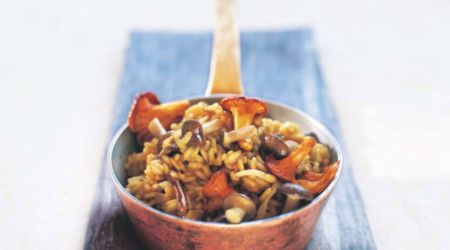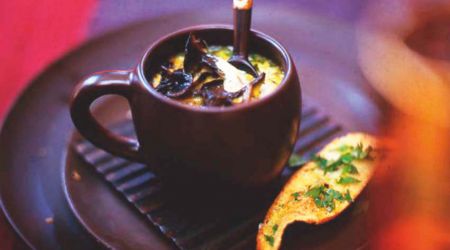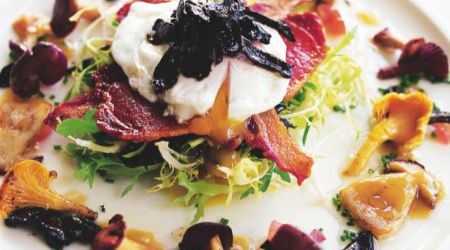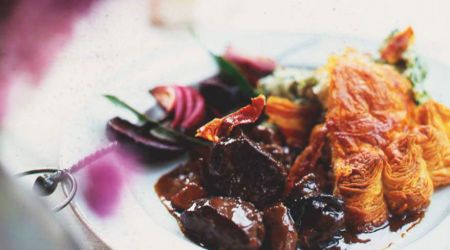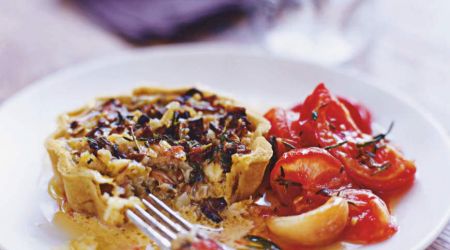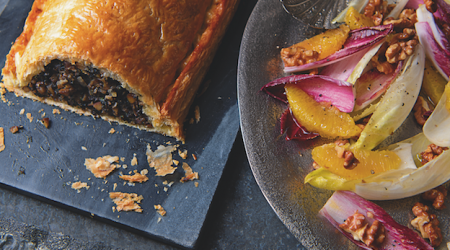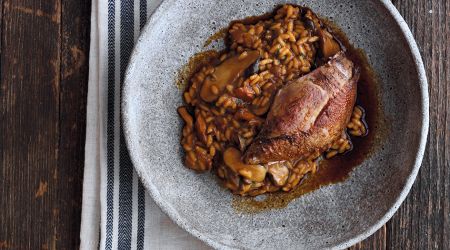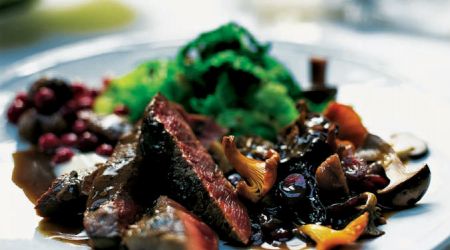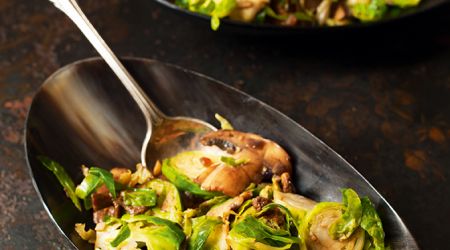Wild Mushrooms
White giant puffballs and slippery jacks, violet-tinged field blewits and shaggy ink caps: these shores harbour strange, beguiling fungi, and the right ones will unleash magic in the kitchen. Clarissa Hyman forages for wild mushrooms and falls under their charm
Mushrooms are the breakfast of champignons’ was a favourite school-room joke. Well, it made us giggle, though Madame, our unbending French mistress, was not amused. In those days, champignons were simply mushrooms: it never occurred to city girls such as myself to distinguish between wild and cultivated varieties. They were all neat white buttons that came packed in a cute little wooden box or slimy and slippery from a can. We knew they weren’t toadstools, that they were unlikely to be magic (at least in north Manchester), but long before today’s foraging frenzy, dashing off to the woods in a delirium of fungi-picking fever was as probable as a trip to the moon. A minor supporting role in the full English or creamy ’shrooms on toast was as racy as it got – if you could brave the texture and dark, satanic juices. Chestnut mushrooms’ pleasing colour and stronger, woodland flavour were a breakthrough. Large, flat portobellos were very grown-up, especially when stuffed with garlic and parsley. (A delicious, contemporary version by Peter Gordon uses cheese, chorizo and thyme.)
Despite appearances, however, these are not wild mushrooms: most supermarket fungi are grown on farms in controlled conditions, perhaps inoculated into logs or on trays with an appropriate compost base. Mushrooms can only be considered truly ‘wild’ when picked in fields and woods. And, as keen foragers are beginning to discover, the UK is home to many more species of mushrooms than you’ll find on the supermarket shelf: some are agreeable to eat, others aren’t, and a few are toxic. The field mushroom, the ancestor of the cultivated white and chestnut mushroom, is one of the easiest to spot when it emerges from the ground, usually in cow pastures, given the right combination of temperature, humidity and soil conditions. Other mushrooms grow on dead wood or rotting vegetation, but most have a complex relationship with the roots of growing plants or trees that result in the fruiting bodies we collectively describe as fungi.
Chanterelles (also known as girolles) are particularly ravishing, with a delicate, slightly spicy flavour, elegant colour and faint apricot aroma. When cooked, they hold their texture better than most, so use in tarts, omelettes or with garlic and cream for a chicken sauce. Ceps (boletus), or porcini as they are known in Italy, are thick, meaty and superb when sliced and fried in butter, garlic and parsley, and sprinkled with lemon juice. The drying process intensifies their flavour and only a few are needed to add savoury depth to a risotto or casserole. Other edible fungi found on our shores include the bleeding brown mushroom and brown wood mushroom, each with white flesh that turns red on cutting; the russula family, a huge category with brightly coloured caps and crumbly flesh; the saffron milk cap, with its crisp texture and lovely colour; and the Jew’s ear, forbidding in appearance but good for slow cooking. Look for the oval white cylinder of the shaggy ink cap, the distinctive mini-brollies of parasol mushrooms or the field blewit, with its fairytale bluish-violet tinge to its stem. Anyone lucky enough to find a white giant puffball should slice it, dip it in egg and breadcrumbs, and fry in butter. But a word of warning: although the names alone are enough to lure and tempt pickers – fat hen, horn of plenty, hedgehog fungus, anise cap, honey fungus, slippery jack – if in doubt, check it out. It is increasingly possible to buy fresh wild mushrooms, though be aware they can be harvested and transported from all over the world, as well as frozen.
Most of the fresh ‘wild’ mushrooms sold in the supermarkets, such as shiitake, oyster and enokitake, are now cultivated; strictly speaking, they should be called ‘cultivated wild’, but that contradiction in terms was never going to catch on in the marketing department. Nonetheless, these ‘wild’ mushrooms have expanded our culinary repertoire. Shiitakes come in a range of sizes: bigger ones have a deeper flavour but also a tougher texture. They can stand up to ginger, soy and chillies, and drying concentrates their flavour, so they go well with steamed fish and red meat. Oysters have a meaty texture and are best stir-fried with noodles over high heat. Bill Granger suggests poaching them with chicken and aromatic coconut milk, or simply sautéeing in soy-flavoured butter.
When buying, look for blemishes and any softness that might indicate rotting. Fresh mushrooms do not keep well, so there is a long European and North American tradition of preservation by brining, pickling, canning or turning them into ketchup. The most usual method, however, is drying. Enthusiastic mycologists have vied with each other over the centuries to tick off the number of varieties sampled, as well as to spur on the doubters. Charles Badham, a 19th-century clergyman, bemoaned that while many poor people were starving, innumerable puffballs, which he compared to beef steaks, were freely there for the picking. Others have been more cautious. John Gerard, in his Great Herbal (1597), warned: ‘Most of them do suffocate and strangle the eater.’ In 1620, physician Tobias Venner described them as ‘earthly excrescences’. It’s enough to put you off your tea. Love them or fear them, there’s a certain magical aura that surrounds mushrooms, especially when they seem to sprout suddenly from nowhere. They retain a degree of ancient mystique – it is said Viking ‘berserkers’ would whip themselves into a fighting frenzy by howling, beating themselves and eating special hallucinogenic mushrooms, such as the fly agaric. Now that’s what I call a breakfast of champions.
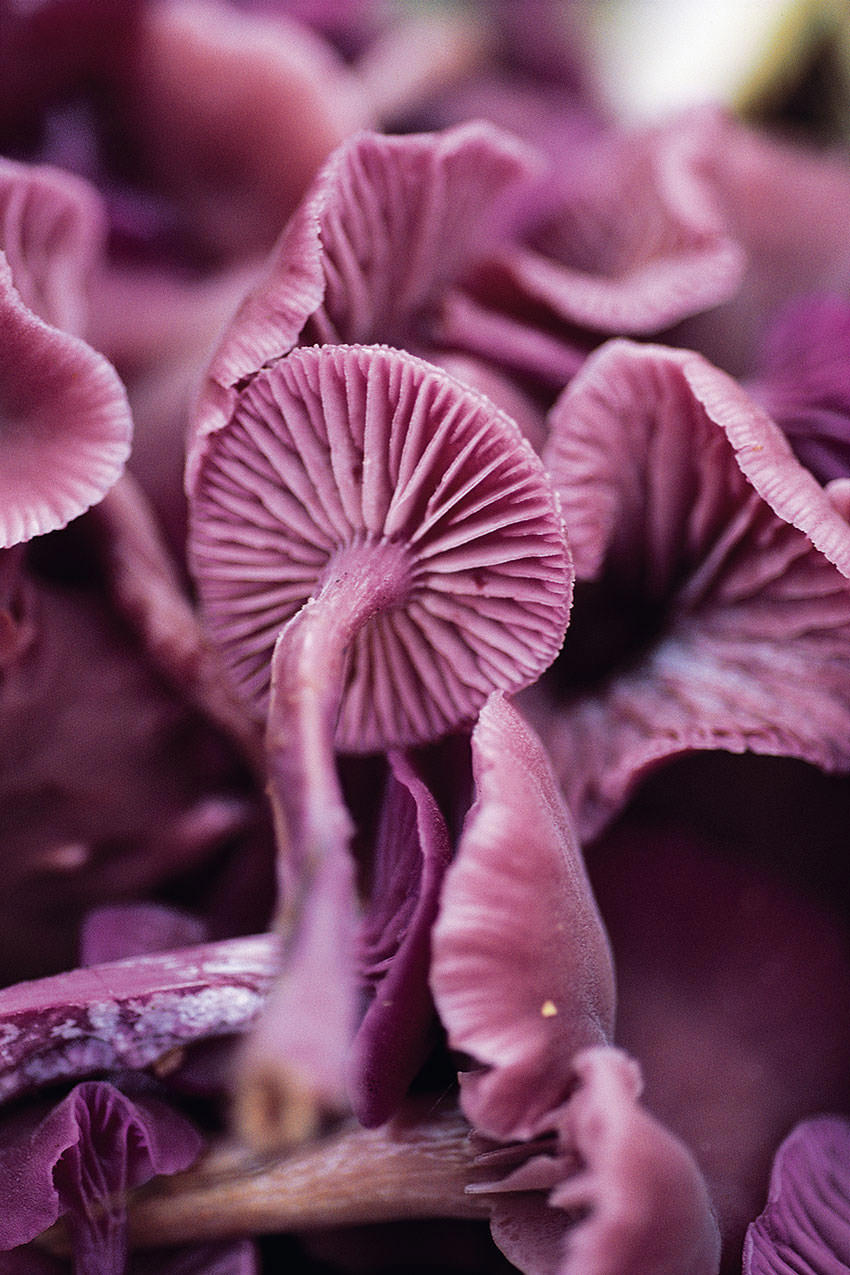
Recipes
Get Premium access to all the latest content online
Subscribe and view full print editions online... Subscribe

